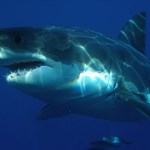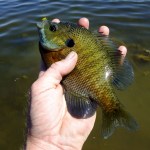shark
Photo of one of Leonie's hatchlings from Tourism and Events Queensland.
The story begins in 1999 when Leonie, a zebra shark (aka a leopard shark in Australia), was captured from the wild. In 2006 she was transferred to Reef HQ Aquarium in Queensland, Australia where she met her mate. By 2008, she had started laying eggs and the pair had multiple litters of offspring through sexual reproduction. After her mate was removed from the tank to prevent further breeding, she has shared the tank with one of her offspring, a female named Lolly who, since reaching sexual maturity…
Photo of a Greenland shark from Wikipedia.
A multi-national team of scientists sought to determine the age of Greenland sharks (Somniosus microcephalus). These animals grow rather slowly (about 1cm per year) and are the largest fish in the arctic (>500 cm long), but their longevity was not yet known. The team used radiocarbon dating of crystalline proteins found within the nuclei of the eye lens. Because these proteins are formed prenatally, they offer a rather accurate way to estimate an animal's age. Their findings, published in Science…
Image of banana shark by Watermeloncat2.0 - Own work, CC BY-SA 4.0, https://commons.wikimedia.org/w/index.php?curid=47324709
I LOVE Shark Week on Discovery Channel. I can't wait to see the bizarre sharks episode. The excitement begins June 26th.
In honor of the Discovery Channel's "Shark Week", check out these shark cams.
National Aquarium Reef Shark Cam:
Broadcast live streaming video on Ustream
SHARK FIN CAM: Video taken from a camera strapped to the dorsal fin of a shark:
Broadcast live streaming video on Ustream
If you have not yet tuned in to Discovery Channel, there are still a few days left of shark week!
Dr. Carl Meyer (University of Hawaii) and Dr. Katsufumi Sato (University of Tokyo) have teamed up to gather data about shark behavior in a rather interesting way. They flipped the animals upside down, which makes them relax, and strapped on cameras and instruments that will facilitate the creation of 3D models of shark movements. Using accelerometers, they are able to measure speed while magnetometers record the magnetic field and additional tools measure the water temperature and depth. The video is used to help contextualize these other data.
Sources:
University of Hawaii
National…
Image from www.clker.com. Woodridge, IL, USA --- Great White Shark Opening Mouth --- Image by © Denis Scott/Corbis
Scientists have discovered that great white sharks (Carcharodon carcharias) actually live longer than previously thought (up to 23 years or so). Using radiocarbon age estimates, Dr. Hamady and colleagues at Woods Hole Oceanographic Institution determined the animals can live to the ripe-old-age of 70+ years. These findings mean that great white sharks, like humans, may take longer to mature. It also means that overfishing may pose more of a threat to them than previously…
Image of a great white shark from Wikimedia Commons.
Dr. Michael Stanhope from Cornell University has discovered that great white sharks actually share more proteins involved in metabolism and biochemistry in common with humans than zebrafish, a common fish model used in biomedical research. They made this discovery by sequencing the transcriptome of a heart isolated from a great white shark. I find it fascinating that sharks have more proteins in common with mammals than with bony fish, even though sharks and bony fish are not very closely related.
Source:
Cornell University Press
This is funny:
Just so you know, he was not fishing for "bluegills" This is a bluegill:
A nice bluegill
Bluegills live in fresh water and are like "sunfish" and "pumpkinseeds" and "crappies" etc. all of which are in the bass family.
Bluefish live in the ocean and roam along littoral regions in large schools. This is what large bluefish look like:
Of course, when one is fishing for bluefish, there is always the possibility of catching the fish that eats them, such as striped bass. Like this:
The striped bass is not in the "bass family" referred to above. Striped Bass are Moronidae,…
While Dr. Barbara Block's team from Stanford University is tagging and tracking sharks in the Northern Pacific (see prior blog), Chris Fischer and his team from History Channel's Shark Wranglers are tracking great white sharks off the coast of Cape Cod...home of "Jaws." You can track these sharks by visiting Ocearch.org.
A great white shark named "Genie" being outfitted with a GPS tracker off the coast of Cape Cod. Image taken by Gretchen Ertl, NY Times.
The goal of this research is to gather data to help protect the animals by learning more about their breeding and migratory habits.…
Dr. Barbara Block from Stanford University, a well-known comparative physiologist and member of The American Physiological Society, has been in the news recently for her work tracking sharks. She has spent her career studying the physiology and migratory habits of ocean wildlife. In a prior blog, I talked about her work tracking bluefin tuna and posted an audio clip of an interview with her talking about how she measures their body temperature, heart rate, etc, using sophisticated tracking devices.
Now you can become part of her exciting ongoing research on shark behaviors through Shark Net,…
Figure 1: Great White Shark, Carcharodon carcharias.
I saw this clip on the news last night, but when I went to look for the video online, it hadn't been uploaded yet. How awesome to find it this morning, already blogged by my friends at LAist!
This video was caught at Will Rogers State Beach in Malibu. Great whites are known to frequent these waters during the summer, so this isn't much of a surprise, but how cool to see the video of them breaching like that!!? At least one of the sharks caught on video has been confirmed by experts at the local non-profit Shark Research Committee to be a…
Treehugger reports on the work of marine scientists at Brazil's Guaruja Aquarium, who have added a plastic window onto a shark egg so they can watch the fish develop.
In the photo above you can see the fetal bamboo shark attached to a large yolk sac. The video below gives a better view.
After noting that the unborn shark was unaffected by the window on its neonatal world, researchers removed the entire animal from its purse and allowed it to grow inside a perspex container. The work will help shed more light on how young sharks develop, an understanding of which is crucial to the…
The tail of a thresher shark (Alopias vulpinus). From Wikipedia.
Thanks to sensational documentaries and summer blockbusters, we are all familiar with the anatomy of a shark attack. The victim, unaware that they are in peril, is struck from below and behind with such speed and violence that, if they are not actually killed during the first strike, they soon find themselves a few pounds lighter in the middle of a billowing red cloud. The trouble is that this stereotyped scenario does not hold for all sharks, particularly one peculiar group of deepwater sharks which has long puzzled…
The jaws of C. megalodon as restored by Bashford Dean for the AMNH in 1909. Image from the American Museum Journal.
My early elementary reading school choices often got me into trouble. Every week I would pass over the recommended, grade-appropriate sections for the few shelves containing the books about dinosaurs, sharks, and alligators - if it was big and hard sharp teeth, I wanted to learn about it. The school librarian was not too pleased with this, even calling my parents in on one occasion to insist that I read something fit for younger children, but I just could not get enough of…
A jar full of dogfish, photographed at the New Jersey State Museum.
A photograph and line drawing (left side) of the fossil dolphin Astadelphis gastaldii. The crescent-shaped line in the line drawing represents the bite of a large shark, with the red portions representing damage done directly to the bone. From Bianucci et al, 2010.
Shark attacks are events of speed and violence. When they have locked on to a prey item sharks seem to come out of nowhere, and though they can be quite gentle with their jaws (as on occasions when they are unsure about whether something is food or not) their ranks of serrated teeth can inflict a devastating amount of damage.…
Not Exactly Pocket Science is a set of shorter write-ups on new stories with links to more detailed takes by the world's best journalists and bloggers. It is meant to complement the usual fare of detailed pieces that are typical for this blog.
The rewarding side of being a psychopath
What goes on in the brains of psychopaths? They can seem outwardly normal and even charming, but tthese people typically show a lack of empathy, immoral behaviour and an impulsive streak. Joshua Buckholtz found that the last of these traits - impulsivity - may stem from a hyperactive reward system in the…
A restoration of the giant, durophagous shark Ptychodus, courtesy paleo-artist Matt Celeskey.
The study of prehistoric sharks is no easy task. Specialists in other branches of vertebrate paleontology at least have the reasonable hope of discovering complete skeletons of their subjects; except in instances of exceptional preservation the scientists who study sharks typically only have teeth and a few vertebrae to work with. Still, you can tell a lot about a shark by its teeth, and a new study published in Cretaceous Research suggests that one peculiar form was a shell-crushing giant.…
I'm back. After a two month hiatus from posting due to the grand opening of Bullitt, my second bar in San Francisco, I have finally adjusted my schedule to accommodate posting, and I'm pumped.
First on my list: I have been looking for years for the best endangered species group to put my support behind. I think I've found it, WildAid. Do you know about them? If you live in Asia, then you have. If you live in the states, then maybe not. WildAid is, in my mind, the most badass endangered species preservation group in the world today. Started by wildlife investigators who were fed up with…
In the middle of the Pacific Ocean, Gonzalo Mucientes has discovered an invisible line in the sea that separates male mako sharks from females. The line runs from north to south with the Pitcairn Islands to its west and Easter Island to its east. On the western side, a fisherman that snags a mako will most probably have caught a male. Travel 10 degrees of longitude east and odds are they'd catch a female. This is a shark that takes segregation of the sexes to new heights.
Mucientes and colleagues from Spain, Portugal and the UK spent four months aboard a Spanish longline fishing vessel.…






